
- Dolby Atmos

Moog Voyager RME (XL) Review
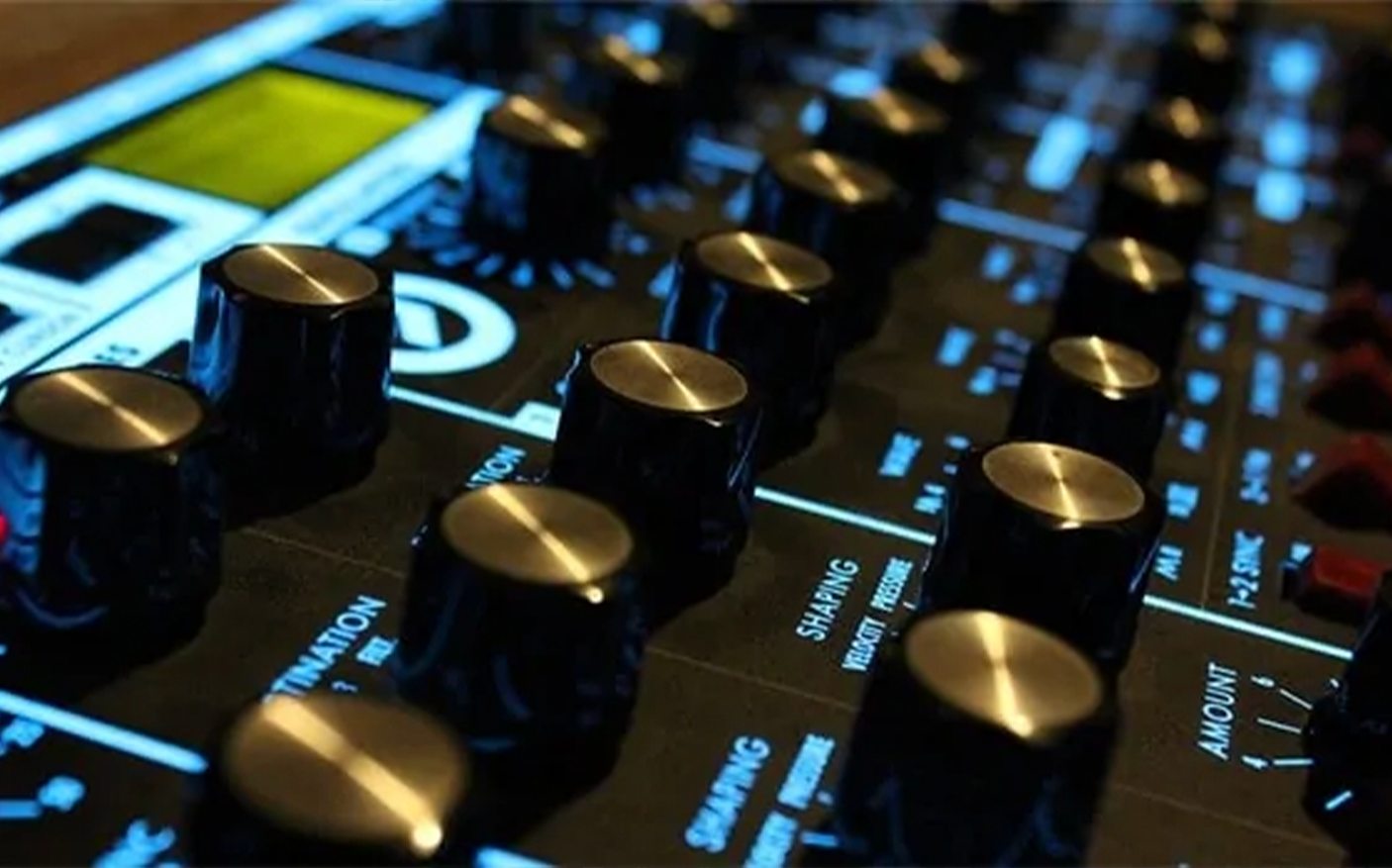
We purchased the Moog Voyager a few years back. We previously owned a Moog Little Phatty and instantly fell in love with the Moog sound. The Moog Voyager sounds unlike any other analogue synth. The classic Moog 24db filter does wonders for your sound and can create those classic Moog basses. Has 3 oscillators sweeping from sine to square waveforms and 2 envelopes one for amplitude and one for filter. The 24db filter has two filter types lowpass and highpass. The resonance on the filter allows you to create squelchy acid bass sounds.
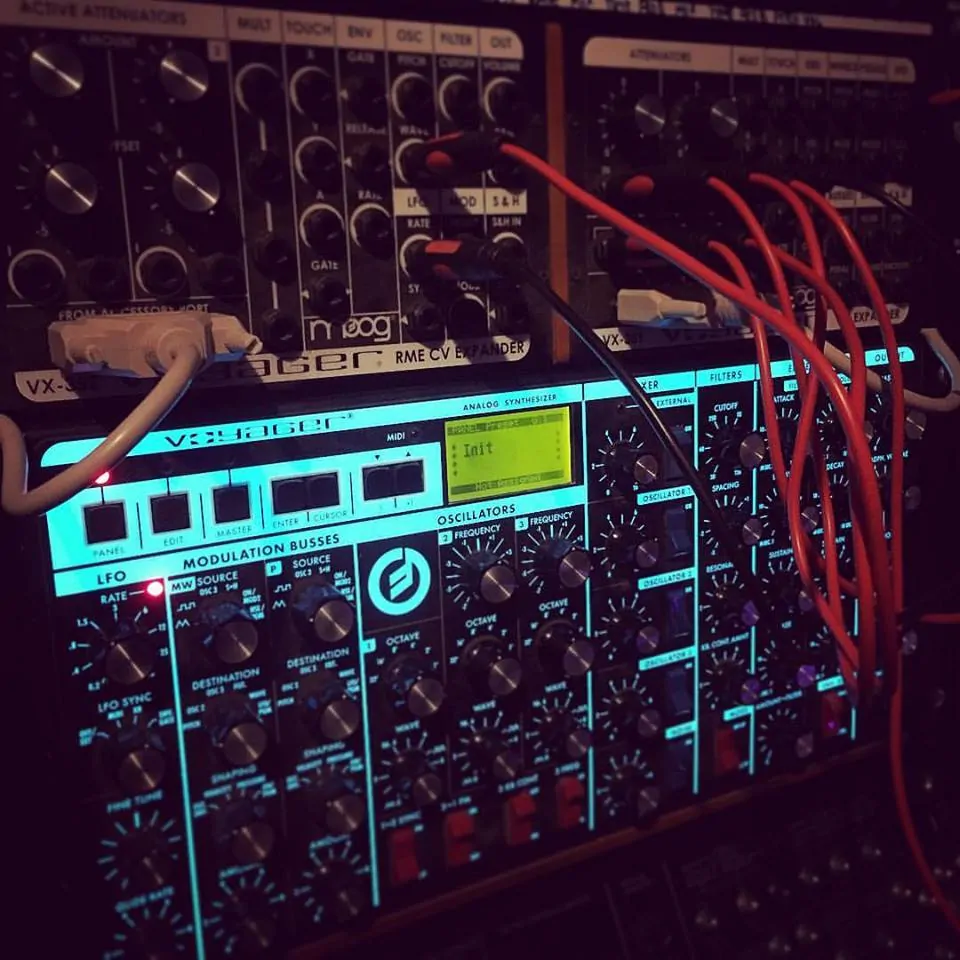
We’ve expanded our Moog Voyager RME with the two addition expanders the VX-351 and the VX-352. This allows you to send control voltage (CV) signals in and out of the voyager. The Moog Voyager has 1000’s of possibilities but expanded the possibilities are endless. Simply route any CV output into any CV input on the Moog Voyager to create a variety of complex patches.
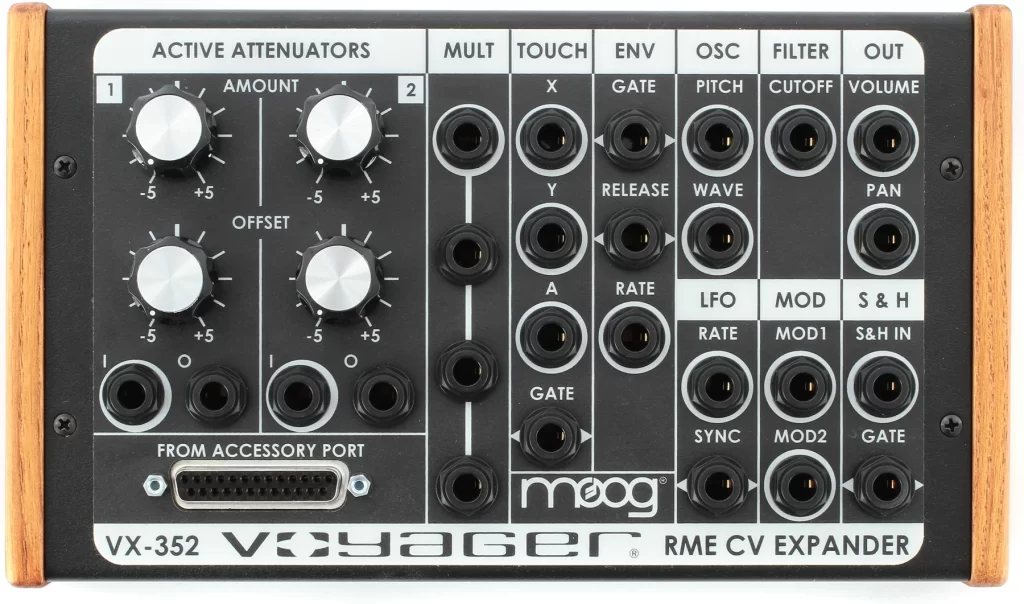
We have also expanded our semi modular Moog with various moogerfooger pedals. We own the lowpass filter MF-101, ring modulator MF-102, 12-stage phaser MF-103, analog delay MF-104 and another analog delay MF-104Z. The moogerfooger pedals are amazing especially the two delay pedals. The original MF-104 analog delay is limited edition and only 1000 units were ever made. The sound achieved using these pedals is incredibly warm unlike any other digital delay. Additionally we have our Moog Minitaur hooked up to the Voyager and use that as a sub oscillator. The Minitaur was designed as a bass synthesizer so works perfectly with the Voyager.
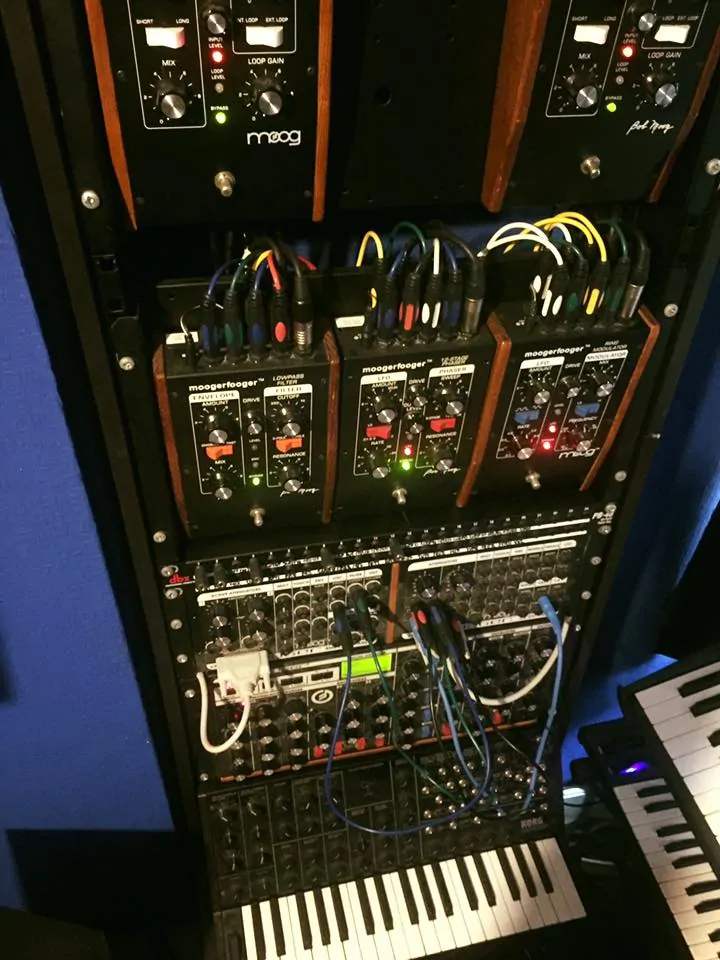
We custom built our Moog Voyager rack from scratch with the idea of standing in front of it for hours patching CV cables and programming complex patches. Step 1 we built the frame the rack will sit in. Step 2 we added rack mounts to each side running all the way to the top. Step 3 we began to add all the units to the racks and wire up the patchbay. Step 4 power on and play.
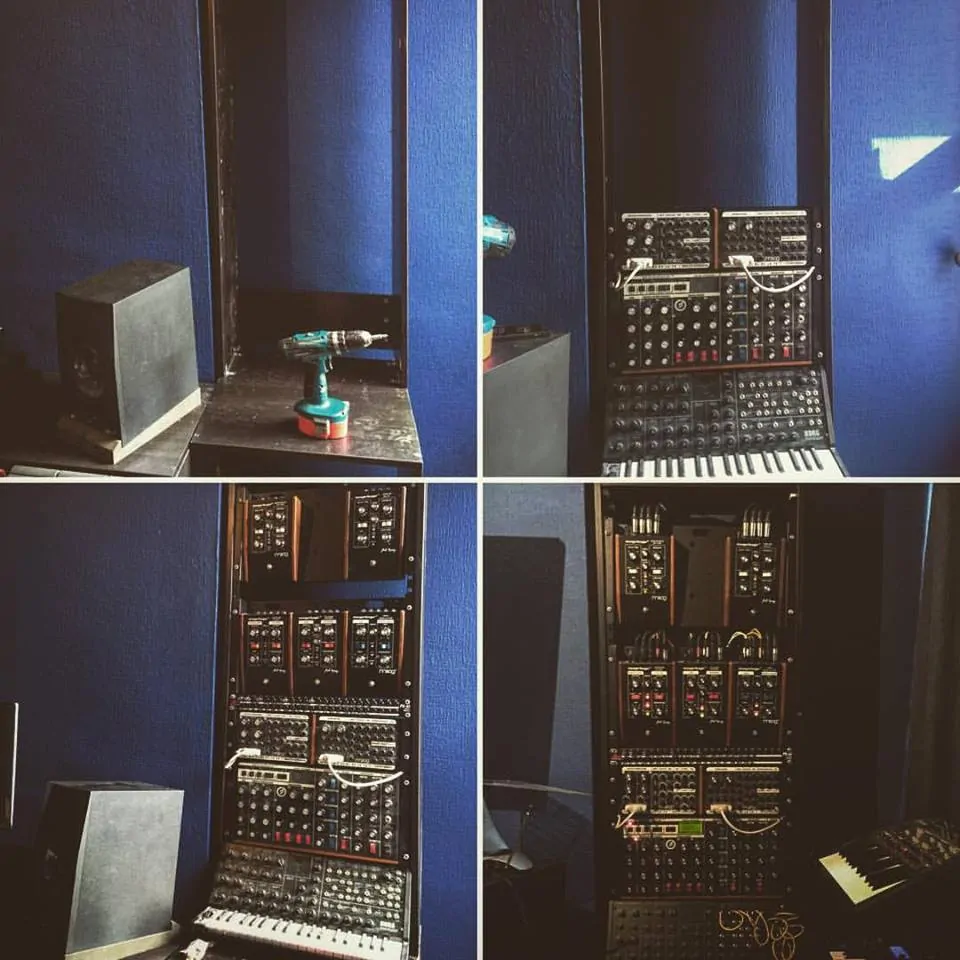
- Privacy Overview
- Strictly Necessary Cookies
This website uses cookies so that we can provide you with the best user experience possible. Cookie information is stored in your browser and performs functions such as recognising you when you return to our website and helping our team to understand which sections of the website you find most interesting and useful. You can read our full privacy policy here .
Strictly Necessary Cookie should be enabled at all times so that we can save your preferences for cookie settings.
If you disable this cookie, we will not be able to save your preferences. This means that every time you visit this website you will need to enable or disable cookies again.

You are here
Voyager by bob moog.
- Synthesizers
Ever since production of the original Minimoog ended in 1981, there have been regular attempts to create a product that would capture the hearts of keyboard players and synth fanatics everywhere in the same way. At last, the man behind the Mini has brought us the Voyager — an updated version of the original Minimoog for the 21st century. How does it compare to the original, how does it sound, and how does it play? Read this in-depth review and find out.
For most, the only way to obtain the true sound of a Minimoog is to buy a second-hand Minimoog. This has sent prices rocketing, and you'll now be looking at spending up to £2000 for a 30-year-old design that plays one note at a time, has no velocity or pressure sensitivity, no dedicated LFO, and no four-stage envelopes, but does have many other limitations. This may seem a lousy deal, but it's one accepted by many; you'll rarely see serious buyers baulk at these prices.
However, given the Minimoog's limitations — it is, after all, a bit of a two-trick pony — surely there's a case for adding the facilities that would make it fit more comfortably in a modern studio, and for plugging the gaping holes in the original specification? In other words, surely there's a place for the Voyager?
The Synth — Oscillators
The Voyager is available in two flavours, the more expensive Signature Edition (reviewed and pictured here) and the standard Perfomer Edition, though in feature and musical terms, they are identical (for details on the differences between them, see the 'Voyager Options & Pricing' box at the end of this review).
Like the Minimoog, the Voyager offers three oscillators. However, the Voyager's Osc1 offers one more audio octave than the Minimoog's (32' to 1') and loses the 'Lo' setting. And, whereas the Minimoog offered six waveform options, the Voyager provides a continuous sweep from triangle to sawtooth to square to pulse waveforms. This is similar to the Micromoog's oscillator, which swept from sawtooth to pulse, but with a wider range of waves. You should not underestimate the value of this, because it makes it possible to apply what we would normally call pulse-width modulation to any of the available waveforms.
Oscillators 2 (which also loses 'Lo') and Oscillator 3 (which does not) are similar, but add fine-tuning controls with a range of approximately ±7 semitones. Again, this is equivalent to the Minimoog layout.
Underneath the eight oscillator knobs, you'll find four switches. The rightmost two of these have direct equivalents in the Minimoog world; '3 KB Cont' disconnects VCO3 from the keyboard CV, and '3 Freq' switches VCO3 between its audio and low-frequency bands.
The other two switches are '1-2 Sync', which hard syncs VCO1 (the master) to VCO2 (the slave). This is something that Moog Music perfected in 1981 on the Moog Source, which remains my preferred instrument for extreme 'sync' sounds. The fourth switch is '3-1 FM' which frequency-modulates VCO1 (the carrier) using VCO3 as modulator. Because the oscillators are extremely stable and track identically, you can create interesting FM timbres and play them across the whole range of the keyboard, which is more than you can say for most analogue synths. Unfortunately, you can't change the modulator's amplitude, so the Voyager always generates a significant number of sidebands. It would have been nice if the Osc3 Level in the Mixer section had taken care of this, but I suppose you can't have everything.
Sync and FM are not mutually exclusive, so you can use them simultaneously to generate a huge range of sounds — some interesting, many just wacky — that are unavailable on the Minimoog and most other non-modular analogue synths. Unfortunately, the oscillators have a limitation; you can only pulse-width modulate all three oscillators simultaneously. A number of classic synth sounds combine a sawtooth wave with a PWM'd pulse wave, so I'm surprised that the Voyager is incapable of this. The Voyager also lacks the Minimoog's A440 tuning oscillator and recessed rear-panel calibration screws, but this is less of a problem, as all three oscillators track accurately over the whole keyboard, and the tuning was consistent and accurate at all footages.
Incidentally, one of the waveforms produced by the original Minimoog appears to be missing from the Voyager; the 'shark's tooth' wave that lies between the triangle and ramp waves on oscillators 1 and 2. In fact, on the Voyager, you'll find something similar between the triangle and sawtooth positions; you can soon obtain its unique sound by adjusting an oscillator carefully. But the ramp wave itself is also missing, and this one isn't hiding — it's gone.
The Dedicated LFO
The number of cyclic LFO waveforms is rather limited — just triangle and square waves — but the LFO scores by generating Sample & Hold, and by offering four Sync options. These are: 'Off/Sync', which free-runs unless you apply a 'sync' clock to the LFO input on the rear panel; 'Kb', which reinitialises the LFO sweep when you generate a keyboard trigger; and 'Env Gate', which reinitialises the LFO when you apply a clock to that input. Didn't I say that there are four sync options? Well, yes, I did, but — despite the annotation on the front panel — MIDI Sync is not yet implemented at the time of writing. More on this later.
The LFO is more powerful than it might seem. For example, you can modulate its rate, thus imitating some of the more impressive sounds generated by the Yamaha GX1 and CS80, and can create polyrhythmic effects by sync'ing the LFO to an external signal running at a different rate, or even generate poly-polyrhythmic effects if you use Osc3 as a second LFO. My only moan about the LFO is that I can find no way within the Voyager itself to use it to auto-trigger the envelopes. This is something that comes in useful occasionally, and which sometimes made the ARP 2600 and Odyssey superior to early Moogs.
Mixer, Overdrive & Effects Loop
Next in the signal path, you'll find the five-channel mixer. This appears to be identical to that found on the Minimoog, with On/Off switches and Level controls for Osc1, Osc2, Osc3, a noise source, and an external audio input. The noise source is superior to that on the Minimoog, lacking the slightly rhythmic quality that some owners noticed on the original. However, it comes in only one 'colour', somewhere between pink and white.
As far as I could hear, the mixer produced no distortion, even when driven maximally by all three oscillators. Some players seem to like distortion in the Mixer, but I think that this part of the signal path should be clean and transparent, as it is here.
The Mixer also provides an effects loop that interrupts the signal path before the filter section. This allows you to treat the raw signal with external processing and/or effects before passing it to the filter. The Voyager's manual suggests that this is where you should apply ring modulation, phasing, delay effects, and a host of other treatments. But much more useful is a trick I learned as a lad...
Few Minimoog players have failed to experiment with feeding one of the instrument's outputs into the External Signal Input. This thickens the sound and, depending upon the synth's calibration, changes the timbre in striking fashion. Do the same thing on the Voyager, and the effect is even more dramatic, causing anything from a mild fattening of the timbre to a full-blooded feedback loop that you can manipulate using the filter, resonance, and all sorts of other controls. If you're into aggressive sounds, this is the way to go.
The first major change between the signal path in the Minimoog and the Voyager appears when you look at the filters. Filters, plural? Yes, the Voyager has two of them. Both have the classic original Moog transistor-ladder architecture, both can be resonant, both can self-oscillate, both will track the keyboard CV, both are affected by the filter envelope, both can be mildly overdriven if the Mixer's output is high enough, and both are affected by the modulators. So, given that they seem to be identical, what's the point in having two?
The answers lie in the Mode switch and the Spacing knob, the first of which allows you to select between dual, parallel low-pass filters, and low-pass/high-pass filters in series, which, of course, constitute a band-pass filter.
In Dual Low-pass mode, you have two low-pass 24dB-per-octave filters at your disposal but, because they are in parallel rather than in series, you cannot combine these to obtain a 48dB-per-octave response. Instead, their outputs appear individually in the left and right channels. This would be pointless, except that the Spacing control then allows you to determine the spacing — up to a maximum of approximately ±3 octaves — between the two filters' cutoff frequencies. This means that, for a given set of filter parameters, you have two signals, one filtered more (or less) than the other.
The Voyager's manual makes grandiose claims about Dual Low-pass mode, and some users have waxed lyrical about all sorts of stereo effects, but to be honest, I am a little disappointed because there is no way to control and modulate the filters individually. It would be quite different if you could sweep one and leave the other unaffected, or have one on the edge of self-oscillation while the other has zero resonance, but you can't. A missed opportunity, I think. On the other hand, I love High-pass/Low-pass mode...
Set the Mode switch to High-pass/Low-pass and the Voyager assumes a very different character, with the Spacing again determining the gap between the lower and upper frequencies. The high-pass filter is not resonant, but in all other ways it acts as before, tracking the filter envelope, tracking the keyboard CV, and responding to the modulators. The output is a little noisier in this mode, but I doubt that many players will find this intrusive. Anyway, you should forget the mechanics, and just play... Suddenly, the Voyager sounds unlike a Moog, and more like an ARP, or even a vintage Korg. The sonic palette is extended dramatically and, to my ears, the instrument springs into life.
If I have to find a fault with the filters, it's in the fact that they do not track the keyboard accurately across its whole width. My 20-something year-old Minimoog does so without hesitation so, in this respect, the Voyager is not its equal. However, this is compensated by the Voyager's provision of variable tracking, which is an improvement over the Minimoog's four options of zero, one third, two-thirds and three-thirds.
Like the Minimoog, the Voyager has a Glide on/off switch to the left of the keyboard (see the picture on page 148), with a Glide Rate control just behind it. Nothing remarkable here, you might think, but there's something strange going on... When you set the Glide to on, you obtain a portamento effect from the oscillators, exactly as you would expect, but the filter cutoff frequency does not glide (it's easy to check this for yourself; just set the filter to self-oscillation, set Glide to on, and play). This suggests that the slew generator is located in the oscillator CV control section, not in the keyboard output. If so, it will be difficult to correct the omission. Now that I think about it, though, I seem to remember that my Crumar Spirit (which was partly designed by Bob Moog) also exhibits this behaviour. Perhaps, therefore, this is not an oversight; maybe that's how the good Doctor likes it.
The Envelopes
The envelopes generated by the Voyager are true ADSRs, not the Minimoog's ADS(D)s. The amplitude envelope is hardwired to the audio signal VCAs (there are two of these, to cope with Dual Low-pass mode) while the filter envelope offers an Amount control that lets you determine the amount — with positive or negative polarity — by which the contour affects the filters' cut-off frequencies. The Voyager's manual claims maximum A, D and R times of 10 seconds, but this is too conservative. Without applying any CVs, I measured a maximum Attack of 14 seconds, and a maximum Release of nearly 40 seconds.
However, the minimum times are more important than the maximum times. Figures of 1ms are quoted in the specifications for each of these, and they are certainly snappy, with a precise click at the start of the note when the Attacks are set to minimum. In fact, you can hear this click even when no oscillator-generated signal is passing down the signal path. Whether this is bleed from the Gate signal, or whether the envelopes themselves generate it, I can't say.
There are two Gate options. Keyboard is the obvious one, whereby a key sends a Gate for the duration that it is pressed. The other is On/External, which either applies a permanent Gate (useful when processing external signals) or derives a Gate from the Env Gate input if a plug is inserted there. There are also two triggering modes: Single and Multi. I usually prefer multiple triggering, but there are times when single triggering is preferable, especially when playing legato passages.
Like the Minimoog, the Voyager offers a Release on/off switch that appears to defeat the 'R' stage of both envelope generators. However, it does not; it shortens the Release considerably, but doesn't reduce it to zero. I can't see the purpose of this. The switch was vital on the Minimoog, but now seems to fulfil no purpose that is not better addressed using the Release knob.
The Modulators
When it came to modulation, the original Minimoog was hugely limited, with just two modulation destinations — oscillator pitch and filter cutoff frequency — for its noise source and/or Osc3. In marked contrast, the Voyager offers two modulation busses controlled primarily by (firstly) the Mod Wheel and (secondly) by a pedal plugged into the Mod1 CV socket.
Each buss starts with six input options that tap eight sources. These are the LFO triangle wave, LFO square wave, Osc3, sample & hold, On/Mod2 (which provides a steady +5V level unless controlled by something plugged into the Mod2 CV input) and Noise/Pgm, which, though it defaults to noise as its source, also provides access to the programmable modulation matrix (more on this in a moment).
Once you have selected the modulation source for either buss, you can choose a destination from the seven options provided: the overall pitch, Osc2's pitch, Osc3's pitch, the filters' cutoff frequencies, the oscillators' waveforms, and LFO/Pgm, which defaults to the LFO speed, but again provides access to the programmable modulation matrix.
You determine the maximum modulation depths using the Amount controls. These are rather too sensitive for my tastes; I found myself using just five to 10 percent of their total ranges. I suppose that they will be useful for extreme modulation effects, but for me it would be better if their responses were more exponential, with the amount accelerating toward the clockwise end of their travels.
Finally, you can apply additional control using the Shaping options. There are five of these: filter envelope, velocity, pressure, and On/Pgm. But this leads me on to my first serious moan, and it's a big one. The Shapers are not additive controllers, they're multiplicative. Without further explanation, that's as clear as mud, so allow me to elaborate...
Imagine that you have an unmodulated sound, and you want to use aftertouch to add vibrato. "No matter", you say, "I'll use the Mod Wheel Buss, set the Shaping to Pressure, and use aftertouch to control the amount of modulation". So you set up the sound, lean on the keyboard, and... nothing happens. This is because, as I said, the Shaper multiplies the amount of modulation applied by the primary controller. If the Mod Wheel is set to zero, then zero times the pressure CV is still zero. The only way round this is to set the Mod Wheel to 'a very little bit', but this means that you can never use the Shapers to introduce modulation into an otherwise unmodulated sound. Secondly, you need to set the Mod Wheel very carefully for this to work and, if you knock it by accident, the modulation either disappears or goes mental.
If you've been brought up on pressure-sensitive synths such as the ARP ProSoloist, you'll find this very unsatisfactory. It looks like it will be possible to patch a solution with the VX351 Expander (of which more later), but my feeling is that this is a lot of money to pay to obtain something so fundamental, especially when the Voyager is already an expensive instrument. As things stand, I find this a shocking oversight, and although the company promise a forthcoming update with an offset facility, so that the multiplicative shaper has something to work on even when the mod wheel is set to fully off, this still means that it won't be possible to modulate an otherwise unmodulated sound, so it's only a partial solution.
The Modulation Busses have one other idiosyncrasy worth mentioning. When you change destinations, the relative pitches of the oscillators are affected by a tiny amount; just enough to change perfect unison to a gentle chorus.
Programmable Modulation
In addition to the panel options, the Voyager's modulation busses have a programmable matrix within Edit Mode. You can select one of eight alternative sources for each buss — noise, filter envelope, amplitude envelope, smoothed S&H, Osc1, Osc2, the as-yet-unexplained TSC 'X' and TSC 'Y' — and one of eight destinations — LFO Rate, Resonance, Spacing, Pan, Osc1 Level, Osc2 Level, Osc3 Level, and Noise Level — for each. This is the same as having access to two 8x8 patchbays, and although you can only use one 'virtual patch cord' in each at any given time, it hugely increases the range of modulation possibilities.
But what are TSC 'X' and TSC 'Y'? To answer this, we must next look at...
The Touch Pad
The large, black 'Touch Surface Controller' (or TSC) dominates the centre of the Voyager. Originally envisaged as a digital 'Tactex' device, this was beset by technical difficulties, so the final product was based on an old capacitative (ie. analogue) design of Bob Moog's.
In basic use, the TSC affects three parameters, with the 'zero effect' point at the centre of the pad. The position of an appendage on the X-axis controls the filter cutoff frequency, the Y-axis controls the filter Spacing, and the area covered by said appendage (or 'A') controls the filter resonance. If you think about the way your fingertip distorts with pressure, you can see that pressing harder covers more area, but the relationship is not the same as true pressure sensitivity. You can also employ more fingers to increase the amount of 'A', or ground the rest of your hand on the metalwork to increase the capacitance, which amplifies the TSC's effect.
As stated above, you can use X, Y and A as modulation sources in the Programmable Modulation system, and there's even a menu option to 'remember' the last position touched so that modulated parameters don't flip back to their default values when you take your finger off the pad. But at present, there's no way to disconnect the TSC from the filters. So, for example, if you're controlling the LFO speed using the pad, you can't do so without also altering the tone in some fashion. What's more, the position memory applies only to the values sent to the modulation busses, not the filter, so the cutoff frequency, spacing and resonance always jump when you take your finger off the pad. Although using the TSC can be fun, serious players will be critical of it for these reasons. Happily, the company claim that forthcoming updates to the Voyager's operating system will allow you to reassign the currently fixed link between the TSC and filter, and also store the filter settings along with the mod buss. I'm pleased to hear this, but unfortunately, there was no sign of these updates before this review went to press.
Inputs & Outputs
The rest of the front panel is straightforward, with fine-tuning, a Master Volume control, an independent headphone level control and its associated output. However, it's round the back that the I/O starts to get interesting. Or, at least, it appears to, but all is not quite as sexy as it seems.
Firstly, like that on the Minimoog, the Voyager's control panel flips up into a range of positions. But if you want to use it 'flat', you can't, because the sockets dip below the piece of wood that runs the whole length along the back of the instrument. If you insert a few cables and then lie the panel flat, all the weight is on the sockets, and this will no doubt lead to electrical failures. Correcting this should be easy; the manufacturers could cut a recess to make room for the plugs and cables. But if the bar is needed for structural rigidity, things may not be so straightforward. Funnily enough, 1998's Welsh Minimoogs suffered from the same problem.
While I'm on this subject, if when flipping the support into position, you lean the section with the controls on it fully forward, its wooden side panels dig into the piece of wood that runs behind the keyboard, causing small indentations. For something so lovingly crafted, the Voyager certainly exhibits some surprising design flaws!
Anyway, of the 18 rear-panel inputs and outputs, four carry audio signals. These are the external audio input, the effects loop, and the stereo audio outputs. The other 14 are control inputs, 11 of which accept continuous CVs, and three of which accept Gates of one sort or another, as shown in the table.
This is an extensive selection, and I'm confident that you'll find no end of uses for them. I particularly like the Envelope Rate input, because this allows me to control the Attack, Decay and Release times using a pedal, which I find very expressive. If you hook the Voyager up to an external synth, you could also use this input to change the 'curve' of these envelope segments.
I placed the Voyager next to an Analogue Systems RS8000 and connected them to each other using a selection of quarter-inch to 3.5mm cables. I also added a Roland EV5 expression pedal to control the second Modulation Buss. Everything worked perfectly, and I was able to clock the S&H and the envelopes, mess with the LFO Sync, generate pulse-width modulation and tweak the filter without any problems. Sure, it would have been nice if there were a filter resonance CV input, as was proposed on an early blueprint for the Voyager but, on balance, I think that the designers got it right.
So, where are the outputs? Surprisingly, they are all contained in the 25-way connector at the far left of the rear panel, and you can't access them without the VX351 CV Expander, which was not available as I wrote this review. The VX351 will be a small box that you can use as a desktop unit or mount in an optional 3U rackmount kit, and will offer 19 CV outputs and two Gate outputs (see the table above) plus two attenuators and two four-way multis.
Now, before you decide that you don't need the VX351, and that you'll make a cable and tap the voltages on each pin... forget it. It appears that the VX351 will come with an output adaptor that you must install inside the Voyager before you can use the 25-way connector.
I'm not happy about being asked to buy an external box to access the CV outputs, and I can see many potential purchasers being upset at having to fork out cash for a set of sockets that might have found homes on the rear of the synth itself. OK, the VX's attenuators and multiples are useful, but I see no reason why the Voyager couldn't have been made a little larger; then everything could have been incorporated into the case. Of course, this would have made the Voyager a semi-modular synth, and it's possible that this was never the intention of the designers.
Mind you, even the addition of the VX351 does not plug all the holes in the Voyager's architecture — in particular, neither the Voyager nor the VX351 offers an inverter. But if you have the cash, you could also add a Moogerfooger CP251 Control Processor, which contains a number of standard synth modules including an LFO, a S&H, a CV mixer, an inverter, two attenuators, a slew generator and a noise source. These extend the capabilities of the Voyager considerably, but add another cost to the equation, to the point that the Voyager and its add-ons become more expensive than some modular synths!
MIDI & Software Updates
Another significant advantage of the Voyager over and above previous Moogs is the provision of MIDI In, Out and Thru. In principle, this should allow you to integrate the instrument fully into a modern studio or live rig. Unfortunately, as it stands, the Voyager displays some marked deficiencies in this area.
Firstly, using the Voyager as a MIDI controller is fraught with problems. On the positive side, it will transmit polyphonically, and sends velocity information. On the negative side, it will not send pressure information, and there is no transposition capability so, if you want to use it to play existing drum maps... you can't. Well, not yet, anyway. The keyboard doesn't go low enough for Roland's, Korg's or the GS or GM note allocations to be of any use.
Likewise, at the time of this review, the Voyager was hobbled when receiving MIDI. It will receive pitch-bend and modulation controllers, but not aftertouch, so you can't control your sounds in the same way as you would if you were playing the Voyager from its own keyboard. At least it responds over a full range; I had no problems playing the Voyager from top to bottom of a 76-note workstation.
I understand that there were other issues with early software revisions, including stuck notes and even lock-ups, but I experienced none of these. The Voyager also proved faultless when sending and receiving Program Change messages. Happily, I understand that the Voyager's MIDI specification is still a work in progress, which brings us properly onto the subject of software updates.
When the Voyager started shipping in the USA, its designers committed what is for me one of the cardinal sins of synthesizer manufacture: they shipped it unfinished. However, the Voyager's relatively late arrival on these shores (see the 'Cambrian Capers' box) has been to the benefit of UK users in this regard, as numerous early bugs have already been eliminated and some oversights corrected. These include all sorts of strange omissions, such as the inability to name patches, or to tweak patches in Panel mode. Also, it is only in the latest version that the old and new parameter values are displayed as you edit them, and that the high-note, last-note and first-note key priorities have appeared in addition to Bob Moog's preferred low-note priority. In my view, these make the 5th February revision (still called Version 1.0) a necessity.
If you have an earlier version, all is not lost. The OS is available as a zipped MIDI SysEx file, and you can obtain this, plus a number of sound libraries, from www.moogmusic.com . Since the review model was up to date at the time of writing, I didn't test the download/upload, but I have no reason to believe that it would be in a problem. Just select 'Receive Update' in the Voyager's menus, and transmit the file to it.
VOYAGER UPDATE SCHEDULE
- 1. Hold -1/+1 buttons to scroll quickly through values.
- 2. Touch surface destinations.
- 3. Filter pole selection.
- 4. Local control On/Off.
- 5. MIDI In on/off & MIDI Out on/off.
- 6. Receive MIDI CCs, Note On velocity & afterpressure.
- 7. Transmit MIDI CCs, afterpressure and pitch-bend.
- 8. Receive MIDI Clock for LFO Sync.
- 9. Send and receive single presets.
- 10. Transpose MIDI output.
- 11. Filter envelope gate source.
- 12. Amplitude envelope gate source.
- 13. Mod Buss PGM shaping.
- 14. System Reset.
Of course, the v1.0 OS is far from the finished item, and there are even a number of hardware functions — such as a promised 12dB-per-octave filter option — yet to be 'turned on'. The Voyager design team supplied me with a list of points which they aim to address over the coming few months, with the upgrades approximately in the order they hope to tackle them. This list is reproduced verbatim in the table above.
Some of the points on the list are self-explanatory, but 2, 3, and 9-12 required further clarification, so I sought this. Point 2 relates to the TSC; as mentioned earlier, the plan is to extend the list of destinations to which you can assign it. Point 3 relates to the aforementioned introduction of a 12dB-per-octave filter mode, and point 9 refers to the fact that it's currently possible to transmit and receive only entire patch banks over SysEx — after this upgrade, it will be possible to send and receive individual presets. Upgrade 10 promises to make it possible to transpose the MIDI output from the Voyager's 44-note keyboard, so that you can use it as a MIDI controller over a much wider range. Points 11 and 12 will make it possible to derive the filter-envelope and amplitude-envelope gates from the external jack input and also the TSC, which could prove interesting. Upgrade 13 is important, as it refers to the offset option for the Mod Buss shapers mentioned earlier, and finally, Point 14 is a simple factory reset.
As I've already made clear in a couple of places in this review, some of these updates stand to correct what are, at present, significant shortcomings, so let's hope that they do indeed appear in a timely fashion, as promised.
When I first saw the Voyager, I was less inclined to play it than I was to find a glass case and display it. The thing has style; from the polished wood to the layout to the front-panel knobs and switches that so clearly recall the original Minimoog.
Plugging it in, you'll find that the Voyager has a universal power supply that accepts any mains signal from 100v to 240v, 50Hz or 60Hz. Bravo! I wish that more manufacturers would use these. The synth is then ready to play almost from the moment you switch it on, with everything warmed up and settled within in a minute or so, which would be unusually quick if it were a vintage synth.
The most obvious differences between the Voyager and its ancestor lie in the centre of the control panel, where you'll find the seven programming buttons and small LCD that provide access to the programming system. Looking more closely, you'll see that there are three system 'modes' — Master, Edit and Panel — plus a cursor button, an Enter button, and +1 and 1 buttons that sometimes double as cursors.
Master mode offers eight menu options that allow you to set up the Voyager's MIDI I/O, and to send/receive the software updates and SysEx dumps of the whole memory (but not, as yet, individual patches). Edit mode is a little more involved, with 13 options that concentrate on performance parameters and keyboard modes, while Panel mode has just four options, the most valuable of which is the one that allows you to see existing and edited parameter values as you tweak the controls.
You would think that, with such a straightforward system, using the Voyager's menus would be a doddle. It isn't, and if there is one thing I dislike about the instrument, it's the way the cursors work; the 'Up' cursor moves you to the menu item below the one currently selected! I suppose that you could argue that the control has moved the menu behind the cursor, but it feels very counter-intuitive to me.
The editing buttons feel a bit lightweight, but the large knobs are both smooth and, well... smooth, with no apparent stepping — the so-called 'zipper' noise suffered by so many analogue synthesizers with memories. This has been achieved by passing the control voltages through the pots in true analogue fashion, meaning that the seven-bit parameter values (0-127) displayed on the LCD are just low-resolution renderings of the actual voltages.
Far less impressive was the time and frustration involved in selecting patches. If I was playing patch #1 and wanted to select #65, I had no choice but to press the 'up' or 'down' button 64 times. Thank goodness there weren't 256, or 512 or even 1024 memories! However, other users have clearly felt the same way, as a fast-scrolling option is at the top of the Voyager update list. Once this is fixed, I think more memories should be provided (especially given the price of RAM), because 128 seems mean by modern standards. To be honest, I found just about everything associated with the Voyager's menus to be somewhat arcane, and I'm not a fan of the programming system.
The 44-note Fatar keyboard is semi-weighted and responsive, and a huge improvement over some of the flimsier offerings I've tested in recent years. Meanwhile, the range of key-priority and triggering modes means that you can set it up to respond like a traditional Moog, an ARP, early Japanese synths, or whatever else you choose. The velocity sensitivity works well, but the aftertouch was far too aggressive for my tastes — it's more like an on/off switch than a progressive controller. This should be addressed, because prospective buyers who use pressure sensitivity as a primary performance controller will be dismayed by the existing response.
There are more serious problems associated with the pitch-bend wheel. Despite the menus offering sensible bend ranges such as a fifth, an octave, and so on, the truth was very different on my review Voyager. For example, the ±1 octave setting offers approximately 13 semitones of upward bend, and 11 semitones of downward bend. Unfortunately, this error scales across all the options, so the only one that is useable is the ±2 semitones range, because the error is less noticeable than on the others. What's more, increasing the bend range flattens the pitch of the whole instrument. This is not good! According to the Voyager design team, this is due to a hardware fault in the pitch wheel that was corrected after the review Voyager was shipped, but of course this affects a large number of instruments already on the market worldwide. The company claim that due to the way the illuminated pitch wheel is designed, it's a simple matter to correct the fault on the Signature Edition. But if you have a Performer Edition with the fault, a chargeable repair may be necessary. If you're thinking of getting a Performer Edition Voyager, it's worth checking that yours belongs to the later batch without this fault.
It's now time to disagree with the yobs on the net who state that the Voyager sounds "nothing like a real Minimoog". I don't have a clue what they're talking about and, to be honest, neither do they.
This statement isn't based on memory, or some rose-tinted memories of the sound of a near-mint, vintage Minimoog. For the bulk of this review, an original Minimoog (number 11235, to be precise) sat next to the Voyager, and direct comparisons were available.
The similarities between the two are unmistakeable when you listen to the oscillators without filtering. Somehow, and I don't know how, the Voyager has been imparted with that indefinable 'Moogyness'; that warm growl that always set the Minimoog and its modular forebears apart from the crowd.
Being very picky, I found that some of the Voyager's waveforms were slightly brighter than the Minimoog's equivalents, requiring me to close the filter slightly to make them all-but indistinguishable from each other. Others required that the filter remained wide open. But, in all cases, the differences between the Voyager and my Minimoog were no greater than between two dissimilar Minimoogs.
The similarities between the two instruments remain apparent when you use the filters, especially when you listen to just one channel in the Voyager's Dual Low-pass filter mode. You can do this by putting a dummy jack in the right socket, or by muting one channel in your mixer. Removing the cable from the right output and playing through the Left/Mono one does not achieve this, because the two signals are then mixed.
However, there are sometimes noticeable differences between the two instruments because, in the Minimoog's filter, the amount of resonance decreases as the cutoff frequency decreases, whether controlled by the keyboard CV or the filter envelope. The Voyager does not exhibit this behaviour. Nonetheless, it does a superb imitation of 'hard' Minimoog leads and basses. It also recreates the Minimoog triangle wave sound used for many softer lead sounds, which was a staple of much '70s prog rock. Having said that, the click at the start of a Voyager note when the envelopes' Attacks are set to zero is a characteristic of the Voyager alone. You may be surprised, but I consider this a benefit in the newer instrument, not a fault.
Returning to the Voyager, it's obvious that you can create and play sounds that extend way, way beyond the Minimoog's palette. The provision of pulse-width modulation across all the waveforms, the extensive modulation capabilities, oscillator sync, FM... there's often more to these options than meets the eye, and you can use them to create a huge range of new sounds. But best of all is the filters' High-pass/Low-pass mode. When playing the Voyager to knowledgeable friends with long histories in the music business, I had no difficulty convincing them that they were listening variously to a Korg 700, a Korg MS20, an ARP ProSoloist and an ARP 2600. Now that's what I call flexibility.
I also spent a few happy hours using the Voyager as a signal processor. Since it was sitting next to my Korg T2 workstation, it was the work of seconds to pass the Korg's output through the Voyager's filter and VCA. Using dual low-pass mode, offsetting the cutoff frequencies, setting the filters' resonances to the point of self-oscillation, and then sweeping them using the Voyager's LFO produced the deepest phasing effects I've ever heard. Given time, I'm sure that I could develop all manner of exciting new sounds.
Conclusions
It has been a pleasure to put the Voyager through its paces and, despite rather more niggles and criticisms than I had expected, my overall impression remains very positive. Sure, the Voyager is not going to appeal to everybody, even after the software updates. Furthermore, many modern players will be amazed that anybody would be prepared to spend between £2000 and £3000 for a monosynth. After all, for less than £1000 you can buy a multitimbral virtual analogue synth that offers multiple voices, huge modulation matrices, and powerful multi-effects units, and which sounds pretty close to a vintage, analogue monosynth.
Equally, there will be those who think that while anything analogue is always going to be more interesting than a digital synth, something in this price band should come with step sequencers, quantisers, inverters, ring modulators, analogue effects, and a host of other facilities that you would find on a self-respecting modular synth.
So let's be clear... The Voyager is expensive, and if you're looking to buy an instrument based on features per pound, this is not for you. However, if you lust after that sound, and appreciate the look and feel of an instrument as well as its sound-making ability, the Voyager doesn't look quite so pricey.
But don't let its ancestry limit your appreciation of its capabilities. The Voyager's ARP and Korg impressions are just as interesting as its imitations of vintage Moogs, and I'm sure that — together with the VX351, the CP251, and other, as-yet-unseen modules — the Voyager could also form the core of a powerful modular synthesis system.
And that, perhaps, is the bottom line. Unlike so much equipment that offers either instant gratification or long-term satisfaction, the Voyager shows every sign of offering both. If you can afford it, check it out. If you can't afford it, check it out anyway... you'll enjoy the experience.
Voyager Options & Pricing
In total, there are only 600 of the Voyager Signature Edition model reviewed here, and Moog Music Inc in the States has now shipped all of these, although some are still available from dealers. These come with a four-year warranty, a certificate of authenticity to confirm that Bob Moog inspected the machine, a gooseneck stage lamp, blue illuminated pitch-band and modulation wheels, a padded gig bag, and a choice of hand-finished cherry, maple or walnut cabinetry.
Production has now switched to the Performer Edition. Originally limited to an oak or walnut case, this now seems to include woods such as sapele and maple. The Performer lacks the 'extras' supplied with the Signature, but is otherwise identical to its predecessor.
Whichever model you buy, the prices (inc UK VAT) are as follows:
- Voyager Signature Edition £2,999.99
- Voyager Performer Edition £2,199.99
- Voyager Performer Edition with blue illuminated wheels £2,299.99
- VX351 Voyager Expander £199.99
- CP251 Control Voltage processor £299.99
UK prices for exotic-wood Performer models and other optional extras such as the VX351 rackmount kit, the gig bag, Voyager flight cases, and the gooseneck lamp are yet to be announced.
New forum posts
- Re: HUM Audio Devices N-Trophy console Arpangel > 28 Apr 2024, 07:39 Recording: Gear & Techniques
- Re: Contrasting/Masking Sounds in a Production amanise > 28 Apr 2024, 06:15 Recording: Gear & Techniques
- Re: I designed a macro dynamic plugin and need some feedback owen841130 > 28 Apr 2024, 05:57 Mixing, Mastering & Post Production
- Re: HUM Audio Devices N-Trophy console Studio Jiimaan > 28 Apr 2024, 03:30 Recording: Gear & Techniques
- Re: What is the magic behind the UAD Ampex ATR 102? yeroc > 28 Apr 2024, 03:14 Mixing, Mastering & Post Production
Active topics
- I designed a macro dynamic plugin and need some feedback
- What is the magic behind the UAD Ampex ATR 102?
- An interesting rehearsal space
- Afro House Sample Pack (Alex Wann,Rivo,Black Coffee Style)
- Equipment repairs in Manchester/Sheffield
- SoundToys Spring Sale at SOUND7
- New Podcast Episode: Drum Machine History
- Alesis QS8 aftertouch query
- Roland reveal Fantom EX range
- Synth Newbie Advice (Interfaces)
Recently active forums
- Recording: Gear & Techniques
- Mixing, Mastering & Post Production
- New Products & Industry News
- Music Business
- Windows Music
- Apps & Other Computers/OS
- Guitar Technology
- Keyboards & Synthesis
- DIY Electronics & Studio Design
- Live Sound & Performance
- Music Theory, Songwriting & Composition
- User Reviews
- Remote Collaboration
- Self-Promotion
Create an account

The Voyager RME one powerful box
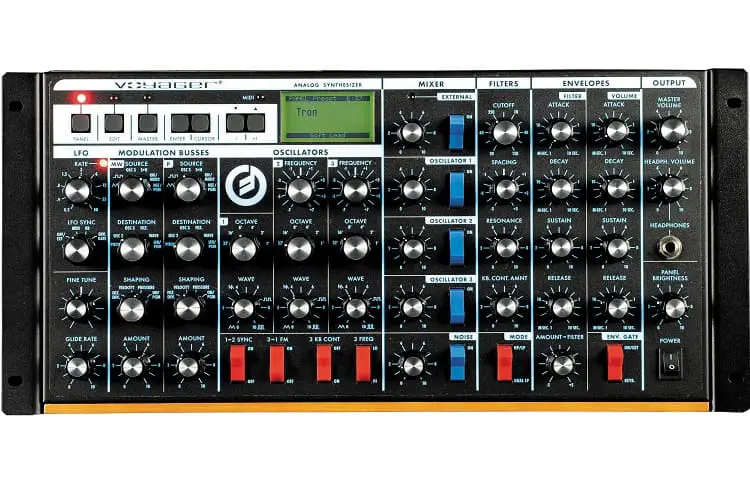
Moog Music has been around for quite a while now, and has given us some of the best synthesizers in use today . When Moog releases something, the whole industry drops what they are doing, and pays attention. It’s simple as that. That is what happened when Minimoog Voyager line got released not so long ago.
This family of products began with a keyboard that has seen several variations, but that was not nearly as impressive as what Moog had in store for us next.
Voyager RME or Rackmount Edition , packed the performance of the Voyager line into a portable rack that you could use with just about any other device.
In essence, we got a chance to experience the somewhat expensive performance of Minimoog Voyager keyboard from a compact rack that could be carried anywhere you need it. Not only did this decision allow a larger number of people to have access to this awesome synth , but it introduced a whole new layer of versatility to this line of Moog products.
If you had a chance to play around with Minimoog Voyager keyboard, you probably already know what to expect from the Voyager RME. Moog pretty much took the whole module and created a standalone package that could be used with a variety of different equipment. Not only that, but you could link numerous RMEs together , and create a killer synth that can do just about anything there is.
The best part about this whole thing is the fact that Voyager line is analog. Having that quality of sound combined with impressive versatility puts the Voyager RME near the top of any synth list there is.
The core of the Voyager RME hasn’t changed much compared to the keyboard it came from . You still have the same architecture and synthesis capabilities, but there are some interesting new features that deserve a mention.
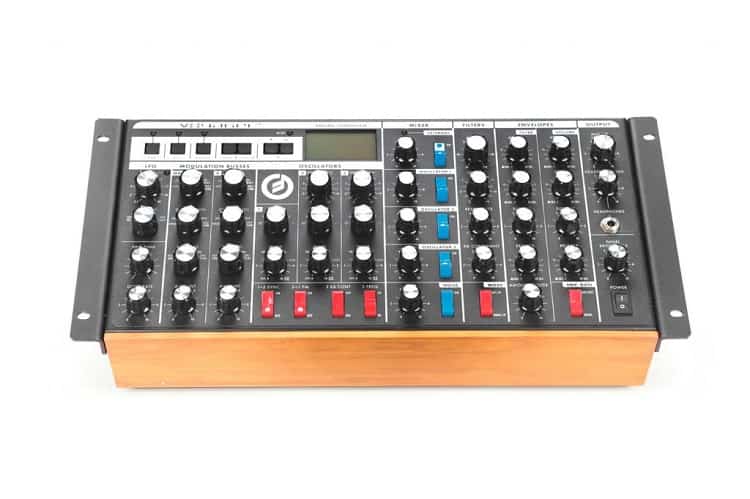
In short, Voyager RME comes with all of the stuff you would expect from a high end analog synth, with the addition of it being mobile.
Performance
If you have a taste for analog sound, you will love this synth. The level of creative freedom you have with the available voltage controlled oscillators is impressive to say the least. If you don’t feel like creating new sounds, you can use any of the 128 modifiable presets .
It’s worth mentioning that the oscillators are pretty stable , giving you a consistent performance. Moog style low pass filters need no introduction , and are just a dream to work with. Having the ability to control this synth with a USB controller feels wrong at first. However, once you realize just how practical it can be, you will ask yourself how you ever lived without such a setup.
What we like
Incredible analog synth quality in a portable package is always a success. No matter what your needs are, Voyager RME will give you all the sound you need combined with incredible versatility.
What we don’t like
There is literally nothing flawed about this synth. It’s Moog after all, and you know exactly what you get with this company. Price is not cheap, but then again we are talking about a top tier analog synth. Doing things the old school way costs money.
Final thoughts
Portable digital synths in a rack form are nothing new. As a matter of fact, they have been used for decades. However, having similar kind of versatility in an analog synth completely changes the game .
Voyager RME is not as small as some digital racks, nor will it ever be. It is small enough to be transported where ever you need it to go, with little to no effort. If money is not an issue, this is one synth you really need to check out.
Leave a Comment Cancel Reply
Your email address will not be published. Required fields are marked *

- Guitars and Basses
- Sound Modules (Expanders)
- Accessories
- Broadcast & Video
- Cables and Connectors
- Cases, Racks and Bags
- DJ Equipment
- Drums and Percussion
- Effect and Signal Processors
- Lighting and Stage
- Microphones
- PA Equipment
- Sheet Music
- Studio and Recording Equipment
- Traditional Instruments
- Wind Instruments
- Latest news Best in Metal - April 2024 Edition
- Latest activity A AC/DC fan took the test for Laney LH50 4 hours 24 min ago
- Latest news The Underground Forest - Volume 24
- Latest activity A Gary Moore fan took the test for Laney LH50 4 hours 24 min ago
- Latest news Interview With Grammy Award Winning Singer Corey Glover
- Latest activity A B.B. King fan took the test for Laney LH50 4 hours 24 min ago
- Latest news Interview With Indie Electronic Artist M. Vaughan
- Latest activity A John Lee Hooker fan took the test for Laney LH50 4 hours 24 min ago
- Latest news SONGS WE LOVED! 15-21 April 2024
- Latest activity A Buddy Guy fan took the test for Laney LH50 4 hours 24 min ago
- Moog Voyager RME
- Synthesizers

Join the Moog Voyager RME Fans Community
Use the tabs below to see what music people who love this gear like, explore its tech specs and read reviews by other members. Stay tuned, more community features are coming up!
- Who is it for
1 review from our community
Please note that the following reviews have not yet been verified for authenticity.

"It fits my needs. I find it an..."
It fits my needs. I find it an excellent deal and I ordered it. The specifics were correct.
3 reasons why people want to buy it
Actual feedback of people who want to buy moog voyager rme.
- "I love it" A Musicngear user
- "Look" A 17 y.o. or younger male fan of Gary Moore from Croatia
- "That it's very cool" A 17 y.o. or younger male fan of Jimmy Page from Slovenia
People that took the "IS IT GOOD FOR ME?" test said they wanted to buy Moog Voyager RME for the above 3 reasons. Their opinion is based on their own independent research and should help in your own purchase decision. Still undecided? Take the "IS IT GOOD FOR ME?" test
Related reviews
We recommend the following related gear as moog voyager rme is not so popular with our community.

"Sound is awesome"
Review of MFB Microzwerg MKII Sound is awesome

"I have 2"
Review of Dreadbox Abyss I have 2

"sound"
Review of Ferrofish B4000+ B-Stock sound

"Built like a tank,knobs and sliders..."
Review of Ferrofish B4000+ Built like a tank,knobs and sliders feel high quality.Great unit for the price!

"It’s tiny, self-contained, MIDI-powered..."
Review of Terrasoniq Ploytec Pi L 2 Synthesizer It’s tiny, self-contained, MIDI-powered and pretty specialized! I'm impressed with this tiny synth!
Moog Minimoog Voyager
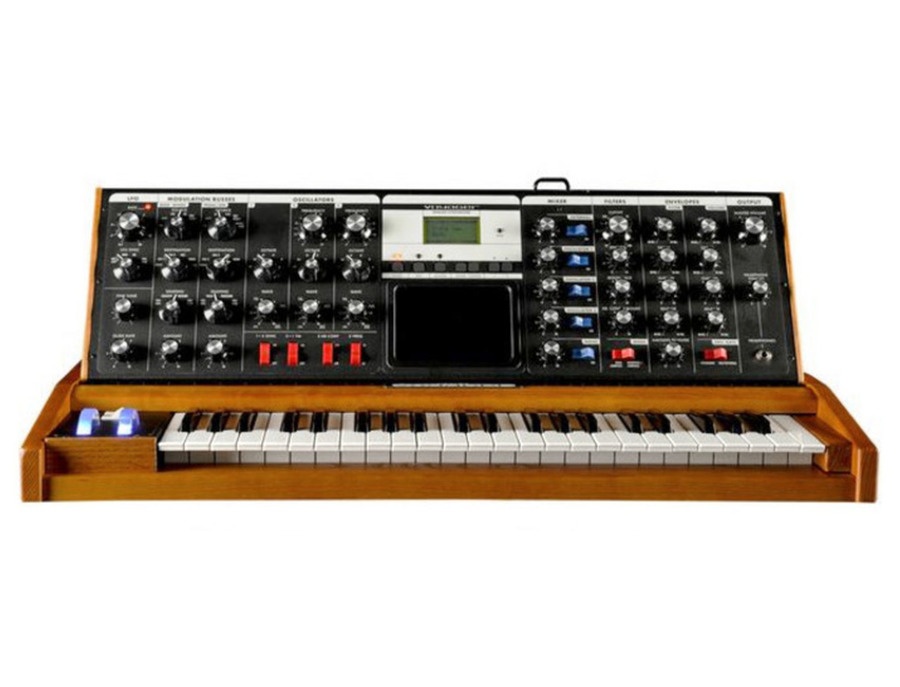
- 0 Keybed provides a unique, immersive playing experience
- 0 Rock-solid reliability and durability
- 0 True analog monophonic synthesizer with classic Moog sound
- 0 Extensive patching facilities and MIDI I/O for versatile connectivity
- 0 Three oscillators and dual filters for rich sound shaping
- 0 Onboard storage for 128 Program memories
- 0 Signature and Performer editions offer aesthetic and functional choices
- 0 Used by renowned artists across genres, adding to its prestige
- 0 Built-in touch surface for expressive control
- 0 Solid hardwood cabinet with hinged control panel for both aesthetics and functionality
- 0 Heavy and bulky, challenging for setups with multiple keyboards
- 0 Audio outputs must be unplugged to fold down the synth
- 0 Pulsing blue lights behind wheels can be distractingly bright
Note: These pros and cons have been generated using Equipboard's AI, which analyzes product reviews submitted by our members, as well as reviews from customers who purchased this product on third-party retailers. Help the community by upvoting pros and cons you agree with, and downvoting ones that are not accurate.
Description
Immerse yourself in the world of sound creation with the Moog Minimoog Voyager , a synthesizer that combines tradition and innovation. Drawing inspiration from the original Minimoog Model D of 1971, this instrument brings the same rich, analogue tone and adds a modern touch with its extensive customization options. The Voyager Select Series, launched in 2006, offers a variety of cabinet woods and backlight options, including Blue, Fire, Indigo, Jade, Lunar, or Solar. This model is a visual delight with a performance to match, identifiable by the 'Select Series' label above the display. Unleash your creativity with its 3 wide range voltage controlled oscillators , a noise source, 2 resonant filters, an external audio input, 2 ADSR envelopes, and an LFO, among other classic traits.
Key Features:
- Inspired by the original Minimoog Model D (1971)
- Part of the highly customizable Select Series (2006)
- Variety of cabinet woods and backlight options (Blue, Fire, Indigo, Jade, Lunar, Solar)
- 3 wide range voltage controlled oscillators
- One noise source
- Two resonant filters
- External audio input
- Two ADSR envelopes
- LFO among other classic traits
- 'Select Series' label for easy identification
Average Price: $3,500 High-end/Boutique
In the Synthesizers category, Moog Minimoog Voyager is priced in the High-end/Boutique range . This premium gear is built to very high standards and offers premium features.
2 AVAILABLE FROM
* Product prices and availability are updated by Equipboard every 24hrs and are subject to change. Equipboard may receive compensation for purchases made at participating retailers linked on this site. This compensation does not affect what products or prices are displayed, or the order of prices listed. Learn more here .
GENRE AFFINITY
194 Artists use this
Found 0 artists

John Frusciante

"His collection includes a Doepfer A100 modular synthesizer, a Mellotron, a Minimoog, and a 1970 ARP 2500. “For a long time I was using m... see details
Skrillex is seen twisting the knobs of a Mini Moog Voyager at 1:46. see details
I checked out this website and in the list of synths,there is a Moog Minimoog listed. It could be this Moog Minimoog Voyager. Guy Man al... see details
Calvin Harris
The Minimoog Voyager is one of the synths in Calvin Harris' studio, it can be seen in several photos and videos. see details
Matthew Bellamy
Mix engineer Tommaso Colliva on recording Drones : "There are fewer keyboards on Drones than on previous albums, and the ones we did use ... see details
From this website. see details
Trusted musician and artist reviews for Moog Minimoog Voyager
Based on 10 Reviews and 85 Ratings
The highly anticipated Minimoog Voyager synthesizer has arrived! This masterpiece of a synthesizer marks two landmarks in the history of synthesizers: the rebirth of the Minimoog and the return of Moog Music! Dr. Robert Moog himself helped design this modern-day Minimoog along with Big Briar. Big Briar (formed by Dr. Moog in 1978) became popular in the nineties with their Moogerfooger analog effect boxes and Etherwave Theremins. In 2002, Moog got the rights back to Moog Music so Big Briar (and all its products) are now Moog Music. Moog Music introduced the Minimoog Voyager synthesizer in two editions: the Signature Edition and the Performer Edition. There were only 600 Signature Edition models and they listed for $3,495 each! Their unique features include: Hand-finished wood cabinet in your choice of genuine solid maple (light), cherry (honey-colored), or walnut (brown), illuminated, clear acrylic Pitch Bend and Modulation wheels, gold-plated nameplate, padded Gig Bag, 4-year warranty with two free factory tunings, and is individually inspected and signed by Bob Moog. The Performer Edition listed for $2,995 and has a solid hardwood cabinet. The Minimoog Voyager is a true analog monophonic synthesizer (probably the most expensive one of its kind) and is based entirely on the original classic Minimoog Model D, which was produced by Moog Music, Inc. from 1970 to 1982. It introduces many new features, including a three dimensional touch pad, MIDI I/O, extensive patching facilities, patch storage, and more! It's cased in a beautiful, solid hardwood cabinet with a multi-position hinged control panel. Just like the original, the Voyager has three analog wide-range voltage controlled oscillators, one noise source, as well as one audio preamplifier for externally-applied audio signals. Two resonant Moog-style filters are on-board and function in dual lowpass or lowpass/highpass modes and can be modulated by one of the two ADSR envelopes, the LFO, or external control. All knobs and switches can have their settings stored into one of 128 Program memories. Program Banks as well as the Voyager's Operating System can be uploaded/downloaded via MIDI SysEx. Centered on its front panel is the ominous, black 3-D (XYZ) Touch Surface which provides three continuously-variable control signals which are derived from the up-down and left-right position of the player's finger, and the amount of area with which the player makes contact to the surface. There's also a 44-note keyboard, this time with velocity and aftertouch sensitivity. Also on-board are Pitch and Mod wheels, Glide/Portamento, and a series of 1/4" CV and/or Pedal jacks lining the top/rear of the front panel. The Mod Wheel can be sent to control all oscillators, or just VCO2, VCO3, the filter cutoff, or LFO rate. The Mod can gets its source from the LFO (triangle/square/sample-n-hold waveforms), VCO3, or the external Mod2 input. A Mixer Module gives you a five-input mixer for combining various audio sources prior to filtering between the oscillators, noise and external audio input signals. The new Minimoog Voyager is a first class synth; every bit as elegant in look as sound and quality. It is highly streamlined and offers all the functionality of a modern day (mono)synth with the classic, warm, unforgettable Moog sound. It WILL replace your original Minimoog (if you're lucky enough to have one). Signature models will become prized possessions for decades to come, and the Performer models will prove to be major players in future of music to come!! It's being used by Stevie Wonder, Maroon 5, the Crystal Method, Electric Skychurch, Duran Duran, Air, Morcheeba, Black Eyed peas, Nine Inch Nails, Blues Traveller, Red Hot Chili Peppers, Dido, The Cure, Herbie Hancock, Rick Wakeman, Yes, Nickelback, Dream Theater, Paul Simon, Joy Electric, the Neptunes, Alicia Keys, CeeLo Green, Madonna, Incubus, FUN, Radiohead, Bjork and more!
would you stop posting marketing propaganda as your reviews?
Best. Synth. Ever.
If you're reading this, you probably already know what it is and what it can do. So rather than review the features, I'll explain why I love it. I was classically trained on piano, and play mostly Jazz / Rock keys and electric guitar. I play with my hands. I step on stompboxes, work the wah, tweak knobs. I'm a knob tweaker. Scrolling through endless presets is not my style. With my Voyager, and all its glorious knobs, I feel like I am really connecting with the instrument not only on a tactile sense but a deeper, creative sense. I can physically adjust every setting by turning and flipping instead of scrolling or swiping, etc. The only thing that could possibly make this any better is if it were a polyphonic. But there are three oscillators, so creating intervals is easily done! And if you like presets, there are some great ones.
Never ceases to bring a smile
I love my minimoog voyager. It's the electric blue one. I find programming it relaxing, fun and entertaining all at the same time. It's well known that the minimoog can produce fabulous bass tones and lead tones but until you actually play them it's difficult to appreciate. This was a vanity purchase really, I've lusted after one since I first heard Lucky Man and Yes. I had to wait 40 years to be. Able to afford one but it's worth it.
$$$$$$$$$$$$$$$$$$$$$$$$$$$$$$$$$$$$$$$
this set me back way more than I would have liked but it is a great synth that I use more than most of my others, I think I need to stay away from moog products, I can't help myself...
The King of Analog Mono Synths
Incredible tone. Absolutely love this synth. The king of bass and vintage sounding leads. Built like a tank. What more can I say?
Bob Moog. Enough said.
From Gear Setup:

does not get any better than ever i think
This is cool. My only hardware-synth.
Low End, Low End
Another beautiful well build piece of equipment.
Very deep and awesome sounding mono synth.
6 Community Gear Photos
Torchandnail.

rettervondunkel
5 alternatives.

Moog Minimoog Voyager RME Rack Mount Edition
This is Moog's rack mount edition of the MiniMoog Voyager, for those who want the authentic Voyager sound in a more portable and space-efficient form factor.

Moog Minimoog Voyager Limited Edition "Select Series" Synthesizer

Moog Minimoog Voyager Lunar Gold Limited Edition


Moog Minimoog Voyager XL Synthesizer

Moog Minimoog Voyager Performer Edition
More synthesizers.
-m.jpg?v=1714220692)
Moog Grandmother
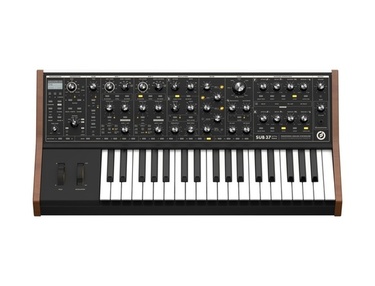
Moog Sub 37 Paraphonic Analog Synthesizer
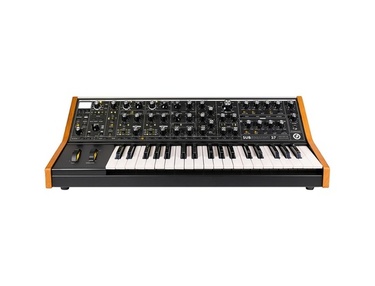
Moog Subsequent 37
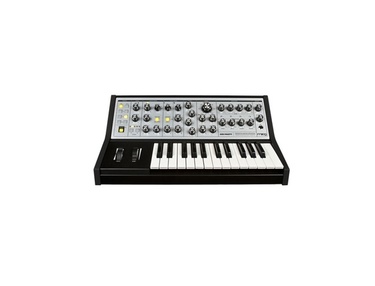
Moog Sub Phatty

Moog Matriarch

Moog One Polyphonic Analog Synthesizer
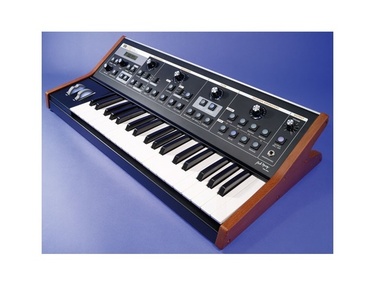
Moog Little Phatty
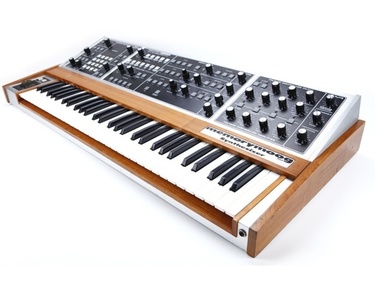
Moog Memorymoog
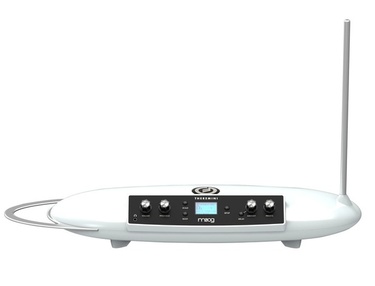
Moog Theremini
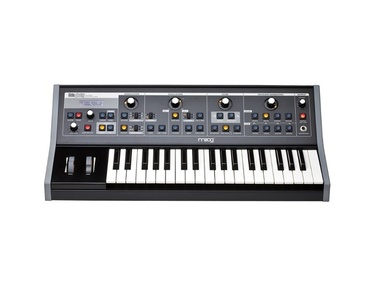
Moog Little Phatty Stage II
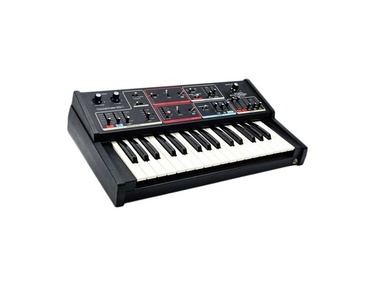
Moog (Realistic) Concertmate MG-1
Moog Subharmonicon
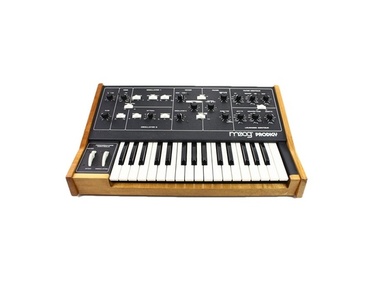
Moog Prodigy

Moog Minimoog Voyager Electric Blue Edi...

Moog Subsequent 25
-m.jpg?v=1714224485)
Moog Grandmother Dark
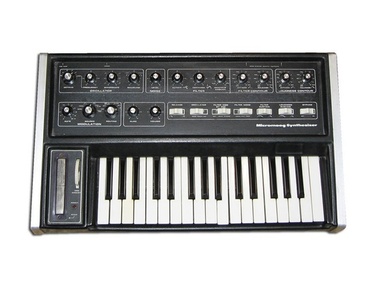
Moog Micromoog

Moog Etherwave Standard
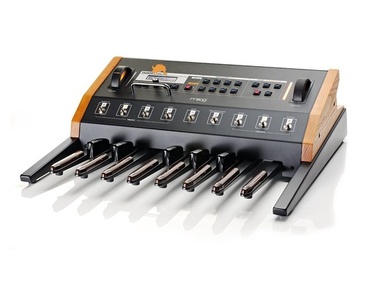
Moog Taurus 3 Bass Pedals
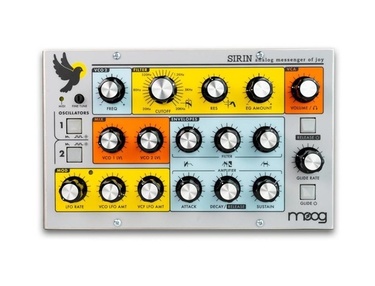
Moog Sirin Analog Synthesizer Module

Moog Source
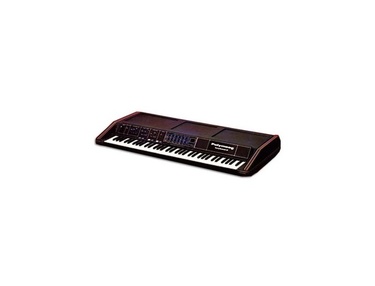
Moog Polymoog Synthesizer
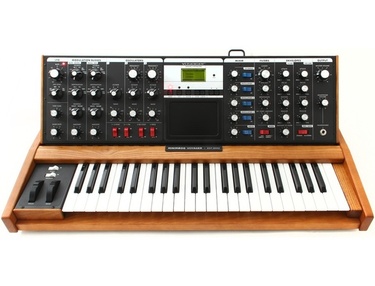
Moog Taurus I
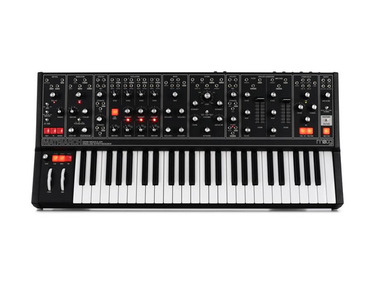
Moog Matriarch (Dark Edition)

Moog Opus 3

Moog Etherwave Plus Theremin
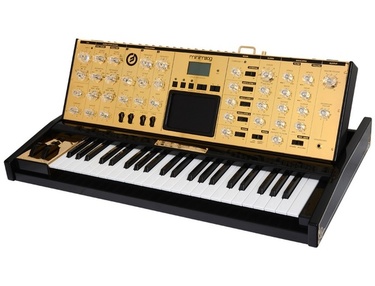
Moog Minimoog Voyager Lunar Gold Limite...
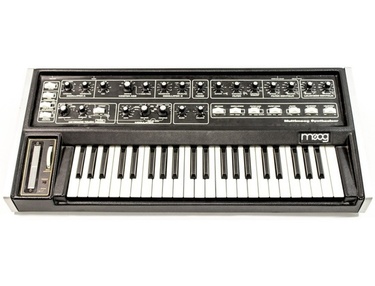
Moog Multimoog

Moog Sonic Six
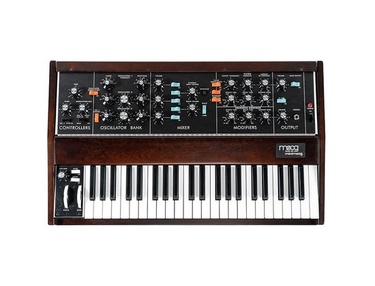
Moog Minimoog Model D Reissue
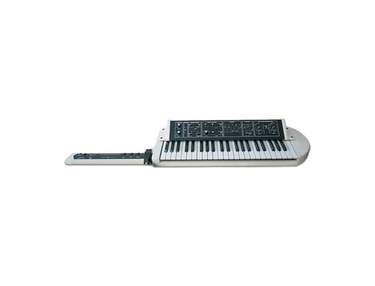
Moog Liberation
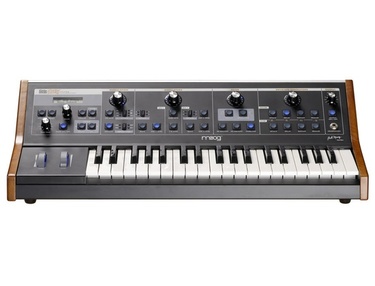
Moog Little Phatty Tribute Edition
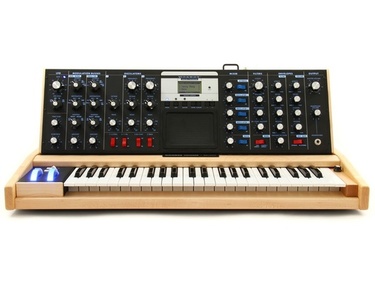
Moog Minimoog Voyager Limited Edition "...
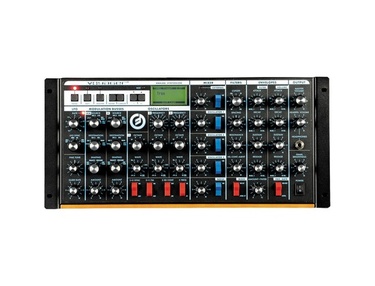
Moog Minimoog Voyager RME Rack Mount Ed...
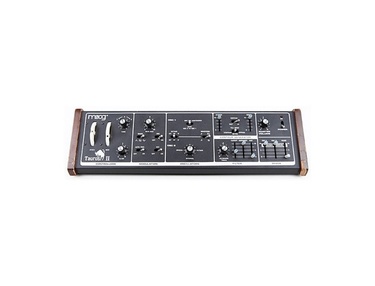
Moog Taurus II
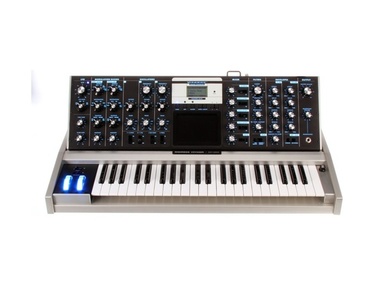
Moog Aluminium Minimoog Voyager
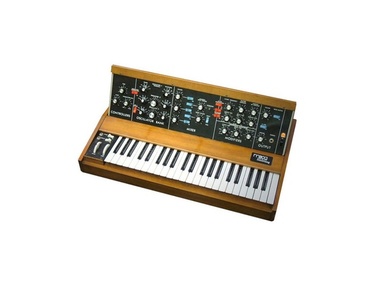
Moog Minimoog Model D
Members who saved this item.
- Call: 888.653.1184
- Los Angeles
- Sell & Trade Gear
- Vintage & Used
- Shop phone Call Shop email Email Chat Chat
- Gear service Service Your Gear Order Status Order Status Order Status Order Status Customer service Customer Service
- View Our Showrooms
- View Our Hours
Shopping Cart Quickview
Checkout using your account
This form is protected by reCAPTCHA - the Google Privacy Policy and Terms of Service apply.
Checkout as a new customer
Creating an account has many benefits:
- See order and shipping status
- Track order history
- Check out faster
Moog Minimoog Voyager RME, VX-352, CP-251, Rack Kit Package
Write a review, product no longer available.
* Required Fields
SHOP BY CATEGORY
MICROPHONES
INSTRUMENTS
Product Description
The MiniMoog Voyager is available in a 19" Rack Mount Edition! The Rack Mount Edition (RME) is five units high and, with optional wood sides, doubles as a tabletop synth. Its backlit front panel includes all of the front panel controls of the Voyager (with the exception of the touch surface). All presets from the Voyager are useable in the Rack Mount Edition.
The Moog Music CP-251 Control Processor can be used in connection with one or more moogerfooger analog effects modules, the minimoog Voyager, or other voltage-controlled gear. The CP-251 adds the same kind of power and versatility of the classic MOOG modular synthesizers. There are two kinds of signals in a modular analog synthesizer: audio and control. As audio signals go through a system of synthesizer modules, they get shaped into the sounds that you hear. Control signals, on the other hand, correspond to the variations in the sound that are imparted by the synthesizer modules, like invisible hands that turn the knobs of the modules. The CP-251 provides a dual waveform LFO, Noise Generator, Sample-and-Hold circuit, as well as two attenuators, a lag processor, a CV mixer and a four-way multi. This gives you ways to modify, mix, and distribute control voltages to product the incredible variety of sounds and effects that analog synthesizers are famous for. Power supply is included: order 110v for use in US or Canada or 220v for use in Europe, Asia, South America, and Australia.
The Moog VX-352 is a control voltage input expander for the MMV Rack Mount Edition. The VX352 adds modular synthesis capability to the MMV Rack by providing inputs control voltages (CV) and gate signals for control of the MMV Rack's synthesis circuits.
More Information
Share your opinion.
The best gear advice always comes from those who use it the most. That's where you come in! Let the pro audio world hear your voice with a review of the Moog Minimoog Voyager RME, VX-352, CP-251, Rack Kit Package . Once you submit your review, please check your email and verify your address to have it posted.
exclamation-circle
View prices for your travel dates
- Excellent 6
- Very Good 11
- All languages ( 25 )
- Russian ( 25 )
- English ( 0 )
Own or manage this property? Claim your listing for free to respond to reviews, update your profile and much more.
ELEKTROSTAL HOTEL
View prices for your travel dates
Reviews we perform checks on reviews. tripadvisor’s approach to reviews before posting, each tripadvisor review goes through an automated tracking system, which collects information, answering the following questions: how, what, where and when. if the system detects something that potentially contradicts our community guidelines , the review is not published. when the system detects a problem, a review may be automatically rejected, sent to the reviewer for validation, or manually reviewed by our team of content specialists, who work 24/7 to maintain the quality of the reviews on our site. our team checks each review posted on the site disputed by our community as not meeting our community guidelines . learn more about our review moderation..
- Excellent 6
- Very Good 11
- All languages ( 25 )
- Russian ( 25 )
- English ( 0 )
Own or manage this property? Claim your listing for free to respond to reviews, update your profile and much more.
ELEKTROSTAL HOTEL - Reviews

IMAGES
VIDEO
COMMENTS
The new price of the Voyager with Keyboard is way to high. But a second hand RME at around £1050 is very hard to beat considering what you do actually end up getting for your money. Lots of features such as memories, ability to record controller data etc.
Moog Minimoog Voyager RME by kraku. Sound Quality. Ease of use. Features. Bang for buck. Overall: "Voyager" is a surprising family of synths by Moog. These synths offer a much wider set of features and sound palette than the classic Minimoog or the more modern Little/Slim Phatty. If you're used to thinking that Moog only offers "that" sound ...
Has 3 oscillators sweeping from sine to square waveforms and 2 envelopes one for amplitude and one for filter. The 24db filter has two filter types lowpass and highpass. The resonance on the filter allows you to create squelchy acid bass sounds. We've expanded our Moog Voyager RME with the two addition expanders the VX-351 and the VX-352.
The Dedicated LFO. Bob Moog and the finished Voyager at its launch.Photo: Mark Ewing Unlike the Minimoog, the Voyager offers a dedicated LFO with a range of approximately 0.2Hz to 50Hz. This is no minor improvement; it frees VCO3 for audio duties, or allows you to use both the LFO and VCO3 as modulators.
The Voyager RME one powerful box. October 14, 2016. When it comes to synths, one name is almost always mentioned in some capacity. Moog Music has been around for quite a while now, and has given us some of the best synthesizers in use today. When Moog releases something, the whole industry drops what they are doing, and pays attention.
Thanks for watching this video! Hope you enjoyed it.Watch my full sound demo here: https://youtu.be/0IFlGdIsBZcBuy this synth for a fantastic price (includes...
The Minimoog Voyager is a true analog monophonic synthesizer (probably the most expensive one of its kind) and is based entirely on the original classic Minimoog Model D, which was produced by Moog Music, Inc. from 1970 to 1982. It introduces many new features, including a three dimensional touch pad, MIDI I/O, extensive patching facilities ...
The Minimoog Voyager Rack Mount Edition takes all the mind-bending power of the Minimoog Voyager and packages it in a 19" package. The Voyager Rack Mount Edition contains all the synthesis functions of the award-winning Voyager. It also includes the Electric Blue back lit panel that we introduced with the Anniversary Edition Voyager, complete ...
Exploring the Moog Voyager RME and some sequences. All sounds were created with this instrument in different multi track layers in Ableton. The Voyager goes ...
Moog presents Sound Modules (Expanders) Voyager RME.If you are on the lookout for synthesizers or keys in general, then this may be a fitting choice. Make sure to check out the reviews but first of all press the red button below to see if it fits your music taste.
The Voyager is a bit on the polite side whereas the LP can be very harsh sounding (in a good way). The Voyager can also do wierd spacey sounds and 1 finger 'pads' better where the LP is more of a lead/bass machine...to me at least. As far as the CV on the RME...I'm actually surprised that the RME has less CV ins/outs than the keyboard version.
Description. The Minimoog Voyager Rack Mount Edition Synthesizer is a monophonic (one note at a time) analog performance synthesizer housed in a 5U Rack Mount Enclosure. The signal path starts with a bank of three wide-range, high-stability voltage controlled oscillators, one noise source, and one audio preamplifier for externally-applied audio ...
In 2005, Moog Music released the Voyager Rack Mount Edition (RME), a synthesizer based on the Voyager. The RME was designed to occupy 5 spaces in a 19-inch rack. The model had all of the features of other Voyagers except the touch panel control and keyboard. The RME was designed to be controlled via MIDI. Up to 16 RME Voyagers could be combined ...
Demonstration of the Moog Voyager RMENo effects, just pure Moog goodness direct through the soundcard and into your ears
The Moog Minimoog Voyager RME, which stands for rackmount edition, serves up all of the power, versatility, and sound of the classic monophonic Voyager in a 5U 19 Rack format. The Voyager RME works well in virtually any setting, from professional studios to stage setups with a MIDI keyboard. Of course, the iconic triple-VCO voicing is featured ...
Trusted musician and artist reviews for Moog Minimoog Voyager. 5.0. Based on 10 Reviews and 85 Ratings. Sort by: Most Helpful. Most Helpful Newest. ADD REVIEW. axvard | 419. 7y almost 7 years ago. Moog Minimoog Voyager. ... This is Moog's rack mount edition of the MiniMoog Voyager, for those who want the authentic Voyager sound in a more ...
Moogyrory wrote: ↑ Thu Feb 06, 2020 1:21 am Hi folks, So tomorrow I will become the proud owner of a voyager rme.... I'm really hoping to source a vx-352, and potentially a vx-351 down the line at some point too.
The Rack Mount Edition (RME) is five units high and, with optional wood sides, doubles as a tabletop synth. Its backlit front panel includes all of the front panel controls of the Voyager (wit Moog Minimoog Voyager RME, VX-352, CP-251, Rack Kit Package - Vintage King
Elektrostal , lit: Electric and Сталь , lit: Steel) is a city in Moscow Oblast, Russia, located 58 kilometers east of Moscow. Population: 155,196 ; 146,294 ...
Elektrostal Hotel, Elektrostal: See 25 traveler reviews, 44 candid photos, and great deals for Elektrostal Hotel, ranked #1 of 2 B&Bs / inns in Elektrostal and rated 4 of 5 at Tripadvisor.
Many travellers enjoy visiting Summery House A.I. Morozova (7.6 miles) and Shirokov House (8.5 miles). See all nearby attractions. Yakor Hotel, Elektrostal: See 6 traveller reviews, candid photos, and great deals for Yakor Hotel, ranked #3 of 4 hotels in Elektrostal and rated 3 of 5 at Tripadvisor.
Elektrostal Hotel. 25 reviews. #1 of 2 small hotels in Elektrostal. Raskovoi st., 6, Elektrostal 144000 Russia. Write a review. Check availability. View all photos ( 44)